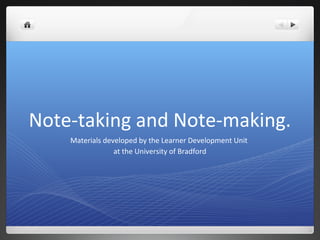
Ntnm student
- 1. Note-taking and Note-making. Materials developed by the Learner Development Unit at the University of Bradford
- 2. Objectives: identify why note-taking is important distinguish between note-taking and note-making recognise different ways of taking effective notes
- 3. Why? Active Learning! Actively engage with your source by participating in: 1. Summary 2. Memory 3. Revision 4. Concentration
- 4. What is taking notes? The Magic Four! 1. Summary – creates an overview of an entire topic by the end of it 2. Memory –writing it down helps you retain the information 3. Revision – allows you to refine and improve your understanding 4. Concentration –being active, rather than passive, requires and prevents distraction and accommodates concentration
- 5. Active Listening and Reading Components Prepare Yourself Sit up straight, have your sources and materials handy, be mentally ready to INTERACT with the source without distractions or disruptions. Make Good Decisions What’s the point of this source? What is important to record? Why? How should you do it? Hearing/Seeing is More than Listening/Looking Even if the source is boring, biased, unattractive, etc., acquire the information needed Patterns Discover patterns of organization and emphasis
- 6. Key Component JOT IT DOWN. Some people make copious notes, others merely need a few key phrases. Even strong auditory learners need something to aid their memory. The message is, don’t just sit there reading or listening – record something.
- 7. Note-taking versus Note-making. It’s simple! Note-taking is recording key information from another source Note-making returning to those notes to annotate, put things into your own words, summarize and highlight, and add your ideas and impressions to the information
- 8. Types of Notes: Linear, Visual or Voiced Linear: typical classroom notes written in words Visual: images, shapes, colors, and other expressions without focus on words Voiced: audio-recorded sources and responses to the source
- 9. Linear Note-Taking Components Create a specific template which you follow for all of your notes. It should include: 1. Title: source and date 2. Purpose of your notes: Why do you want to learn this? 3. Purpose and Background of Source Information 4. Main points, examples, and evidence (this is the big part) 5. Questions raised by the source
- 10. Visual Notes Diagrams, charts, tables, graphs, maps Colors, sizes, styles Symbols, icons, doodles
- 11. © 2007 Expanding Paradigms
- 12. Voiced (or Audio) Notes Helps reinforce learning and aids auditory learners Use any technology that records but does not distract others. Lectures and Lessons Record a lecture and play it back later. Then record your own notes of what you remember from what you have heard and compare with the original source. Texts Take pictures or download files of sources to use outside the classroom. Be sure this is okay with the creator and presenter of the source.
- 13. Note-Taking / Note-Making Note Taking Note Making As you learn from the source, take notes here! After you have finished learning, make notes here! (review Slide 7)